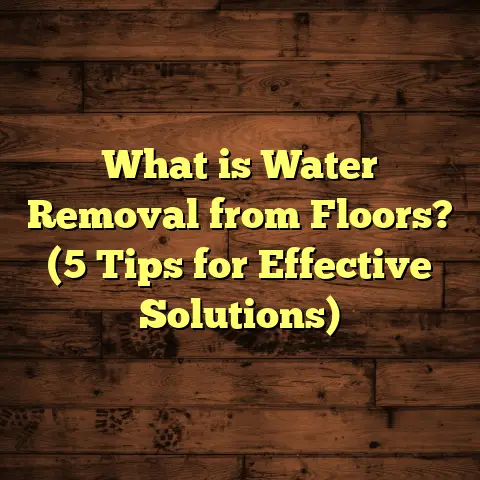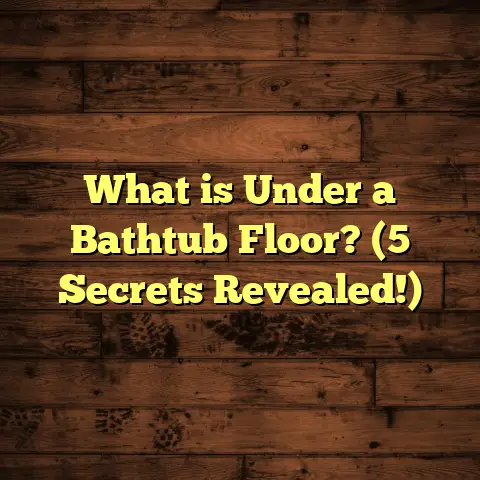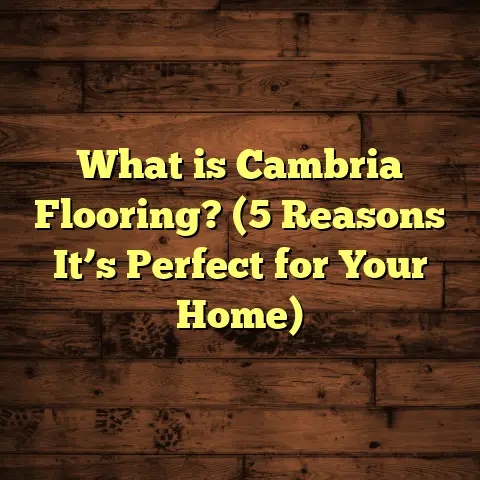What is a Floor? (5 Key Types & Their Uses Explained)
What is a Floor?
I want to start by sharing a little story. Years ago, when I first stepped into the flooring business, I didn’t realize how much a floor could shape the feeling of a space. One project sticks with me—a family renovating their old farmhouse. The original floors were worn out hardwood, creaking underfoot and scarred from decades of life. We restored those floors with care, sanding and refinishing every plank. When the family saw the finished floor, their eyes lit up. It wasn’t just wood anymore—it was a part of their home’s soul. That’s when I truly understood: a floor is more than just something to walk on.
So, what exactly is a floor? At its core, a floor is the surface that forms the bottom of a room or building. It’s what supports everything—from your furniture to your footsteps. But beyond this basic definition lies layers of complexity. Floors are engineered systems combining structural elements (like subflooring and joists) with finish materials (wood, tile, carpet, vinyl, etc.). They have to handle weight, resist wear and moisture, and contribute to the room’s comfort and aesthetics.
In practical terms, floors protect us from the ground below while shaping how a space looks and feels. They influence acoustics, warmth, safety, and even indoor air quality. Floors can uplift the design language of a home or commercial building and affect how people interact with the space.
Over the years, I’ve worked with many different floor types—each with its own strengths, challenges, and ideal uses. Below I’ll share the five key types I encounter most often. I’ll explain what makes each special and how they fit into real-life applications.
Hardwood Floors: Living History Underfoot
Hardwood floors are often called the gold standard of flooring—and I get why. There’s an unmatched elegance and authenticity wood brings into a room.
What Makes Hardwood Special?
Hardwood comes from solid planks milled from trees like oak, maple, hickory, cherry, and walnut. Each species offers distinct grain patterns and colors. Because it’s natural wood, hardwood is breathable and adapts slightly to humidity changes—though it can still be vulnerable to excessive moisture.
When you install hardwood floors, you’re not just adding surface material—you’re adding character that can last generations. Some hardwood floors in historic homes are over 100 years old and still going strong.
From a technical standpoint, hardwood is durable and can be sanded and refinished multiple times. This means small scratches or dents don’t have to be permanent—over time, you can bring the floor back to life.
Real-World Uses & Why I Recommend Hardwood
I often suggest hardwood for family rooms, dining rooms, hallways, and bedrooms—areas where foot traffic is moderate but appearance matters. Hardwood adds warmth that often makes rooms feel inviting and cozy.
One memorable project was a client restoring an early 1900s Victorian home. They wanted to keep the period feel but update the floors for modern use. We sourced reclaimed oak flooring to match the original wood species used in the home. The end result? A floor that looked authentic yet met today’s durability standards.
However, I usually caution clients against installing hardwood in bathrooms or basements due to moisture risks which can cause cupping or warping.
Installation: The Nitty-Gritty
Installing hardwood requires skill. The subfloor must be clean and level before nailing or gluing down hardwood planks. Depending on the product, installation methods vary:
- Nail-down is typical for solid wood over wooden subfloors.
- Glue-down works for engineered hardwood over concrete.
- Floating floors use locking mechanisms without nails or glue but are more common in engineered hardwood.
Prefinished hardwood saves time by coming sanded and sealed from the factory—less dust on site and faster completion.
Caring for Hardwood Floors
I tell clients to treat hardwood floors with care:
- Sweep or vacuum regularly to remove grit.
- Use rugs near entryways to reduce dirt tracked in.
- Wipe spills immediately to prevent stains.
- Refinish every 7-10 years depending on wear.
A well-maintained hardwood floor improves home value significantly. Data from Remodeling Magazine shows that hardwood flooring installation averages about $6,000-$9,000 for 1,000 square feet but can add over 70% return on investment when selling.
Laminate Flooring: Practical & Stylish
Sometimes clients want wood looks but at a lower price point or easier upkeep. That’s when laminate flooring comes into play.
What Exactly Is Laminate?
Laminate flooring consists of multiple layers:
- A core made from high-density fiberboard (HDF).
- A photographic image layer simulating wood grain or stone.
- A clear protective wear layer that resists scratches and stains.
This structure makes laminate very resistant to everyday damage like pets’ claws or kids’ toys dropped on the floor.
Where Does Laminate Shine?
Laminate is great for living rooms, offices, hallways—even kitchens if you choose water-resistant varieties. I’ve installed laminate in many rental units because it holds up well to heavy use without breaking the bank.
The Resilient Floor Covering Institute reports laminate floors have an abrasion resistance rating (AC rating) between AC3 (residential moderate traffic) to AC5 (heavy commercial), so you can pick based on your needs.
Installation & Maintenance
Laminate uses a “click-lock” design making installation straightforward—ideal for DIYers or fast professional installs. It usually floats above the subfloor on foam padding for sound insulation and moisture barrier.
Cleaning laminate is simple: dry mop or vacuum regularly; clean spills quickly with damp cloths; avoid harsh cleaners or standing water.
Personal Experience
Once I installed laminate in a busy daycare center where durability was critical. The client appreciated how easy it was to clean and how it endured constant foot traffic without visible wear after a year.
Cost-wise, laminate runs about $1.50-$3 per square foot for materials plus installation—much cheaper than hardwood but still visually appealing.
Vinyl Flooring: Waterproof & Versatile
Vinyl flooring has evolved spectacularly over recent years. It’s no longer just budget flooring—it looks good and performs well too.
Vinyl’s Composition
Vinyl floors are made from synthetic polyvinyl chloride (PVC) layers, including:
- A backing layer for support.
- A vinyl core providing strength.
- A printed design layer mimicking natural materials.
- A clear wear layer with urethane or aluminum oxide for durability.
Luxury vinyl planks (LVP) and tiles (LVT) especially mimic wood or stone finishes beautifully.
Practical Applications
Vinyl excels in rooms exposed to water like kitchens, bathrooms, basements, and laundry rooms. It’s also comfortable underfoot due to slight flexibility compared to tile or hardwood.
According to Floor Covering Weekly magazine, vinyl accounted for nearly 30% of residential flooring sales in 2023 due to its performance features.
Installation Insights
Vinyl installation varies:
- Sheet vinyl requires adhesive applied over smooth subfloors.
- LVP/LVT often uses click-lock floating methods similar to laminate.
- Glue-down options exist for commercial-grade durability.
I remember fitting vinyl flooring in a restaurant kitchen where spills and foot traffic were extreme—the waterproof nature saved costly damage later.
Maintenance Tips
Vinyl is easy to maintain:
- Sweep/dust mop regularly.
- Use manufacturer-approved cleaners.
- Avoid abrasive tools that can scratch surface.
Vinyl flooring costs typically range from $2-$7 per square foot installed depending on quality and style.
Tile Flooring: Durable Beauty with Endless Styles
Tile is one of my favorite materials because of its adaptability and longevity.
What Tiles Are Made Of
Most floor tiles are ceramic or porcelain:
- Ceramic tiles are made from clay fired at lower temperatures.
- Porcelain tiles are denser, fired at higher temperatures making them harder and less porous.
Both types resist stains, scratches, and moisture very well.
Where Tile Works Best
Tile is ideal for bathrooms, kitchens, mudrooms—anywhere durability and water resistance matter most. Outdoor patios also benefit from frost-resistant tile varieties.
The Tile Council of North America states properly installed tiles can last 50+ years with minimal maintenance.
Design Flexibility
Tile comes in countless shapes, sizes, colors, patterns—from classic subway tiles to intricate mosaics. This versatility makes it easy to create unique looks ranging from rustic farmhouse kitchens to sleek modern bathrooms.
Installation Challenges & Rewards
Tile installation requires careful surface prep:
- Subfloor must be level.
- Proper thin-set mortar application is critical.
- Grout must be sealed periodically to prevent stains.
I’ve installed tile in historic renovations where matching original tile size and pattern was essential. Attention to detail paid off beautifully.
Costs vary widely: ceramic tiles average $5-$10 per square foot installed; porcelain can go higher depending on style and labor complexity.
Carpet: Comfort & Warmth Underfoot
Carpet may not be everyone’s first choice today but it has valuable benefits—especially for comfort seekers.
How Carpet Is Made
Carpet consists of fibers (wool, nylon, polyester) tufted into backing material with padding underneath for cushioning.
Comfort & Noise Control
I love installing carpet in bedrooms because it adds softness underfoot and muffles footsteps—great for families with young kids or shared walls.
Research from the Carpet & Rug Institute shows carpeted rooms reduce sound transmission by up to 50%, improving privacy in apartments or multi-level homes.
Best Uses & Limitations
While carpet is cozy for bedrooms and living areas, it’s less practical in wet zones due to moisture retention risks leading to mold if not ventilated well.
Allergy sufferers may prefer low-pile carpets or hypoallergenic fibers that trap less dust mites.
Installation & Maintenance Tips
Carpet installation involves stretching over padding using tack strips around edges for secure fit. Quality padding improves longevity and comfort significantly.
Regular vacuuming combined with professional deep cleaning every 12-18 months keeps carpet looking fresh.
Costs range from $2-$5 per square foot installed depending on fiber type and padding quality.
How I Use FloorTally for Cost Estimation
Managing budget expectations has always been a challenge in my line of work. Over time I started using FloorTally—a tool that streamlines cost calculations by factoring material types, labor rates based on local markets, waste allowances, and room dimensions all in one place. It saves me hours of manual quoting.
By inputting project specifics into FloorTally:
- I get instant cost breakdowns per room.
- Can compare material options side-by-side.
- Visualize total project cost easily.
- Plan materials order accurately reducing waste and reorders.
This helps set clear expectations with clients upfront so there are no surprises halfway through installation. It also allows me to prioritize upgrades based on budget versus aesthetic goals effectively.
Deep Dive Into Flooring Trends & Data Insights
Through hundreds of projects across residential and commercial spaces, I’ve noticed some interesting trends:
- Sustainability: More clients ask for eco-friendly options like bamboo flooring or recycled-content carpets.
- Waterproof Flooring: Demand for waterproof vinyl and engineered wood has surged in humid climates.
- Smart Home Integration: Heated floors using electric mats under tile or hardwood growing popular.
- Design Preferences: Matte finishes replacing high gloss; wider planks creating spacious looks; multi-tonal wood patterns trending upwards.
A recent survey by Houzz showed that 38% of homeowners planned flooring upgrades focused on durability first followed by design appeal.
Case Study: Renovating an Open-Concept Family Home
Last year I helped renovate an open-concept home where flooring choice was critical for flow between kitchen, dining, living room, and hallway.
We chose engineered hardwood in main living areas for warmth and continuity but switched to porcelain tile in kitchen islands and mudroom entrances for water resistance. Bedrooms had plush carpet for comfort at night.
The client loved how distinct zones were defined without disrupting overall unity thanks to smart flooring transitions using reducer strips blending materials seamlessly.
Total project covered about 2,500 sq ft with combined costs estimated via FloorTally within client budget including labor contingencies—no surprises at final invoice either!
Final Thoughts From My Experience
Floors may seem like a basic element but choosing right impacts your lifestyle daily—from comfort walking barefoot to ease of cleaning after kids spill juice. Over time I’ve learned no single flooring fits all needs—understanding each type’s characteristics helps homeowners make choices that last decades without regret.
If you’re thinking about flooring options now or planning future renovations—consider where you live (humidity?), who uses the space (kids? pets?), maintenance willingness—and what look you want day after day.
I’m always happy to talk through options based on my hands-on experience so you get floors that truly feel like home beneath your feet. What questions do you have about your current or future floors? Let’s keep this conversation going!





